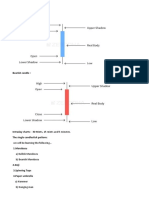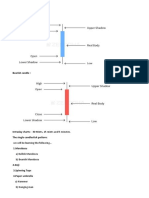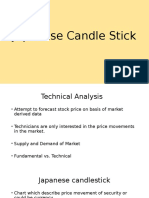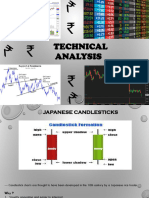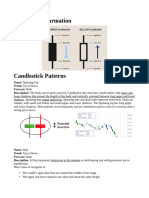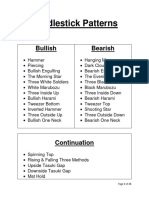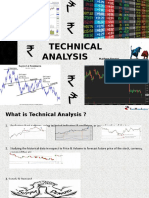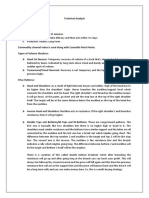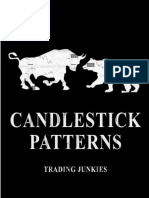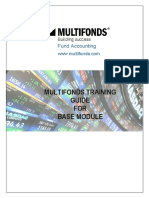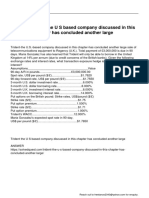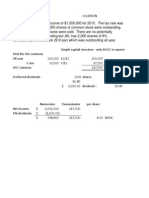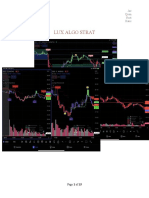Assumptions of Technical Analysis
Market discounts every thing
The ‘how’ is more important than ‘why’
Price moves in trend
History tends to repeat itself
Japanese Candlestick
Long bodied candle - Depicts strong buying or selling activity
Short bodied candle - Depicts less trading activity – less price movement
Rules specific to candlesticks
Buy strength & Sell weakness – Buy on a blue candle day & Sell on a red candle day
Be flexible with patterns
Look for a prior trend – If you look for a bullish trend the prior trend should be bearish & vice versa
Trade trap
One should avoid trading during extremely small candle (below 1% range) or long candle range
(above 10% range)
Single Candle Stick Patterns
1. The Marubozu
Textbook definition – No upper & lower shadow – just the real body
Violates the Rule 3 – Can appear anywhere in the chart irrespective of the prior trend
The Bullish Marubozu
o Open = Low & High = Close
o Indicates that there is so much buying interest in the stock that the market participants
were willing to buy the stock at any price point during the day.
o It does not matter what the prior trend is
o This action suggests that the sentiment has been changed and the stock is now bullish.
o The trader should look at buying oppurtunities
o In reality there can be minor variations from the definition (The variation is price is not
much when measured in %).
o Buy price – H - around the closing price of the
marubozu
Stop loss – L - Low
The Bearish Marubozu
o Open = High & Close = Low
o Indicates so much selling pressure on the stock
indicating that the market participants sold at
every point during the day
o This action suggests that the sentiment has been changed and the stock is now bearish.
o One should look at Shorting opportunities
o Selling Price – C – Closing price of the candle
Stop loss – H
�2. The Spinning Top
Have Small Real body
The Upper & Lower shadows are almost equal
It just conveys indecision as both bulls & bears were not able to
influence the markets
Spinning Top in downtrend
o Either there will be another round of selling
o Or the markets could reverse the direction & the prices
could increase
Spinning Top in uptrend
o The bulls could be consolidating their positions before initiating another leg of up move
o Or the bulls may give way to bears – Correction could be around the corner
3. The Dojis
Very similar to the spinning tops except that – doesnot have a real body at all
Open & Close are equal and there can be wafer thin body
Upper and Lower shadows can be of any length
Color does not matter
The dojis and spinning tops appear in clusters – Indecision in the market
4. Paper Umbrella
It is characterized by Long lower shadow & Small upper body (open & close should be almost same
i.e, within 1-2% range)
Shadow to real body ration shall be atleast 2
(Length of real body = Close - Open & Length of lower shadow = Open/Close – Low)
Helps the traders in setting up directional trades
It consists of two trend reversal patterns
Can be of any color.
The Hammer formation
o The prior trend should be down trend & it occurs at the
bottom of the trend
o The longer the shadow – the more bullish the pattern
o Stoploss - L - Low of the hammer formation
The Hanging man
o Appears at the top end of a trend & it is preceded by an uptrend
o For a case of Short Sell
o Stoploss – H
5. The Shooting Star
An inverted paper umbrella
It has a long upper shadow and length of the shadow should be atleast twice
the length of the body
Color doesn’t matter
It is a bearish pattern & hence the prior trend shall be bullish
Stoploss – H
�Multiple Candle Stick Patterns
1. The Engulfing Pattern
It needs Two trading sessions to evolve
The Bullish Engulfing Pattern
o Its appears at the bottom of the trend & the prior trend should be a downtrend
o P 1 : Should be a Red candle
P 2 : Should be a Green Candle – Long enough to engulf the red candle
o Stoploss – Lowest Low between P1 & P2
o As the long as the real bodies are engulfed, can be classified
as bullish engulfing pattern
o Validation : CMP at 3:20 on P2 > P1’s Open
Open on P2 <= P1’s Close
The Bullish Engulfing Pattern
o It appears at the top end of the trend
o P 1 : Should be a Green candle
P 2 : Should be a Red Candle – Long enough to engulf the Green candle
o Validation : Open on P2 > Closing of P1
CMP at 3.20 on P2 < P1’s Open
o Stoploss : Highest high of P1 & P2
2. The Piercing Pattern
Very similar to bullish engulfing
In this pattern, P2’s blue candle partially engulfs P1’s red candle & such engulfing
shall be >50% & <100% ( if P1 range = 6, P2’s range = 6 to 12)
Stoploss : Low of the pattern
3. The Dark Cloud Cover
Similar to bearish engulfing pattern
The Red candle on P2 engulfs on P1’s Blue Candle about to 50% to 100%
2. The Harami Pattern
The Bullish Harami
o It appears at the bottom end of the trend
o P1 : Red Candle
P2 : Blue Candle
o Validations : Open of P2 > Close of P2
CMP at 3.20 on P2 < Opening of P1
o Stoploss : Lowest low of the pattern
The Bearish Harami
o Appears at the top end of the trend
o P1 : Blue Candle
P2 : Red Candle
o Validation : Open of P2 < Close of P1
Close on P2 > Open of P1
o Stoploss : Highest between P1 & P2
o

